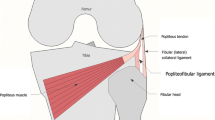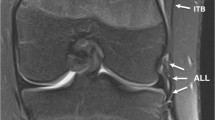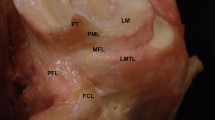Abstract
Objective. Popliteal muscle and tendon injuries are thought to be unusual. This report describes the magnetic resonance (MR) appearances of popliteus muscle and tendon injuries.
Design and patients. The study included 24 patients where the diagnoses of popliteal injuries were prospectively made based on MR appearances. The study group was taken from 2412 consecutive knee MRIs. The injuries were characterized as to involving the muscular or tendinous portions of the popliteus apparatus.
Results. In 95.8% (23/24) of patients, the tears of the popliteus involved the muscular portion. The injuries were either partial and interstitial or complete. Three patients had tears of both the muscular and tendinous portions or the tendon alone. The anterior and posterior cruciate ligaments were torn in 16.7% (4/24) and 29.2% (7/24) of patients, respectively. There were medial and lateral meniscal tears in 45.8% (11/24) and 25% (6/24) of patients, respectively. There were injuries of the medial and lateral collateral ligaments in 8.3% (2/24) and 4.2% (1/24) of patients, respectively. Bone bruises and/or fractures were seen in 33.3% (8/24) patients. In 8.3% (2/24) of patients, the popliteus injury was an isolated finding.
Conclusion. Popliteus muscle and tendon injuries are not uncommon. They usually occur in conjunction with other significant injuries of the knee and can be characterized with MR imaging.
Similar content being viewed by others
References
Seebacher J, Inglis A, Marshall J, Warren R. The structure of the posterolateral aspect of the knee. J Bone Joint Surg [Am] 1982; 64: 536.
Staubli H, Birrer S. The popliteus tendon and its fascicles at the popliteal hiatus: gross anatomy and functional arthroscopic evaluation with and without anterior cruciate ligament deficiency. Arthroscopy 1990; 6: 209.
Burstein D, Fischer D. Isolated rupture of the popliteus tendon in a professional athlete. Arthroscopy 1990; 6: 238.
Garth W, Pomphrey M, Merrill K. Isolated avulsion of the popliteus tendon: operative repair. J Bone Joint Surg [Am] 1992; 74: 130.
Mann R, Hagy J. The popliteus muscle. J Bone Joint Surg [Am] 1977; 59: 924.
Gruel J. Isolated avulsion of the popliteus tendon. Arthroscopy 1990; 6: 94.
Mirkopulos N, Myer T. Isolated avulsion of the popliteus tendon. Am J Sports Med 1991; 19: 417.
Naver L, Aalberg J. Avulsion of the popliteus tendon — a rare cause of chondral fracture and hemarthosis. Am J Sports Med 1985; 13: 423.
Rose D, Parisien J. Popliteus tendon rupture. Clin Orthop 1988; 226: 113.
Baker C, Norwood L, Hughston J. Acute combined posterior cruciate and posterolateral instability of the knee. Am J Sports Med 1984; 12: 204.
Baker C, Norwood L, Hughston J. Acute posterolateral rotatory instability of the knee. J Bone Joint Surg [Am] 1983; 65: 614.
Hughston J, Jacobson K. Chronic posterolateral rotatory instability of the knee. J Bone Joint Surg [Am] 1985; 67: 351.
Author information
Authors and Affiliations
Rights and permissions
About this article
Cite this article
Brown, T.R., Quinn, S.F., Wensel, J.P. et al. Diagnosis of popliteus injuries with MR imaging. Skeletal Radiol. 24, 511–514 (1995). https://doi.org/10.1007/BF00202148
Issue Date:
DOI: https://doi.org/10.1007/BF00202148




